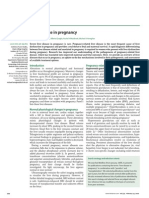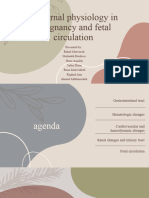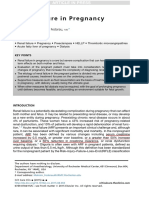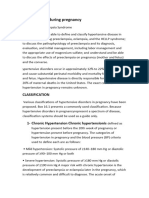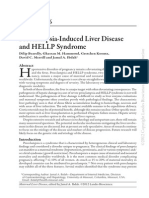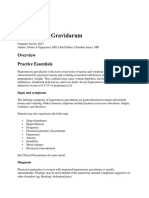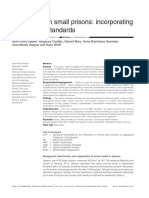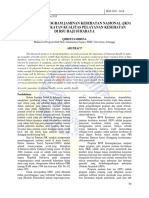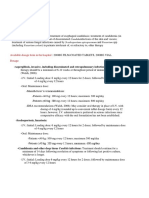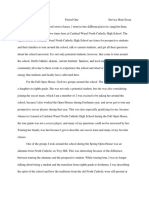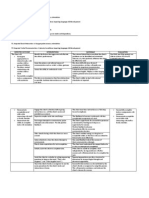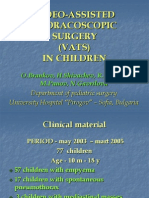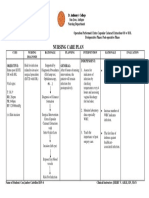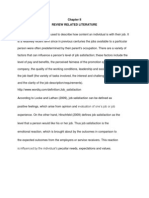Jaundice in Pregnancy
Jaundice in Pregnancy
Uploaded by
Anonymous mvNUtwidCopyright:
Available Formats
Jaundice in Pregnancy
Jaundice in Pregnancy
Uploaded by
Anonymous mvNUtwidOriginal Description:
Original Title
Copyright
Available Formats
Share this document
Did you find this document useful?
Is this content inappropriate?
Copyright:
Available Formats
Jaundice in Pregnancy
Jaundice in Pregnancy
Uploaded by
Anonymous mvNUtwidCopyright:
Available Formats
Review
Liver disease in pregnancy
Deepak Joshi, Andra James, Alberto Quaglia, Rachel H Westbrook, Michael A Heneghan
Lancet 2010; 375: 594605
Institute of Liver Studies,
Kings College Hospital,
London, UK (D Joshi MRCP,
A Quaglia FRCPath,
R H Westbrook MRCP,
M A Heneghan MD); and
Department of Maternal-Fetal
Medicine/Obstetrics and
Gynaecology, Duke University
Medical Centre, Durham, NC,
USA (A James MD)
Correspondence to:
Dr Michael A Heneghan, Institute
of Liver Studies, Kings College
Hospital, Denmark Hill,
London SE5 9RS, UK
michael.heneghan@kch.nhs.uk
Severe liver disease in pregnancy is rare. Pregnancy-related liver disease is the most frequent cause of liver
dysfunction in pregnancy and provides a real threat to fetal and maternal survival. A rapid diagnosis dierentiating
between liver disease related and unrelated to pregnancy is required in women who present with liver dysfunction
during pregnancy. Research has improved our understanding of the pathogenesis of pregnancy-related liver
disease, which has translated into improved maternal and fetal outcomes. Here, we provide an overview of liver
diseases that occur in pregnancy, an update on the key mechanisms involved in their pathogenesis, and assessment
of available treatment options.
Introduction
Pregnancy-related liver diseases
Alterations in normal physiological and hormonal
proles occur throughout pregnancy. Moreover, changes
in liver biochemical prole are normal in pregnancy.
However, up to 3% of all pregnancies are complicated by
liver disorders.1 Severe liver disease, although rare, can
occur and leads to increased morbidity and mortality for
both mother and newborn infant. Liver disorders were
once thought to be trimester specic, but this is not
always the case. As such, liver disease in pregnancy can
be related or unrelated to pregnancy. Liver disease
unrelated to pregnancy can be further classied into preexisting disorders that might become active during
pregnancy and those co-incident with pregnancy. Panel 1
lists these liver diseases.
Hyperemesis gravidarum
Normal physiological changes in pregnancy
A rise in maternal heart rate, cardiac output, together
with a fall in blood pressure and systemic vascular
resistance, all occur during pregnancy. These alterations
mimic physiological changes in patients with
decompensated chronic liver disease. Blood volume
increases by about 50%, peaking in the second trimester.
However, blood ow to the liver remains constant and
the liver usually remains impalpable during pregnancy.
Telangiectasia or spider angiomas and palmar erythema
are normal ndings in pregnancy and are caused by the
hyperoestrogenic state. Gall bladder motility is decreased,
which increases the lithogenicity of the bile.
During a normal pregnancy, serum albumin concentration falls due to the expansion in plasma volume,
and the alkaline phosphatase activity increases due to
added placental secretion (table 1). In general, aminotransferase concentrations (alanine aminotransferase
and aspartate aminotransferase), bilirubin, and gammaglutamyl transpeptidase all remain normal throughout
pregnancy, and their change should be further
investigated. On light microscopy, the liver appears
normal or near normal.2
Ultrasonography remains the safest imaging modality
to visualise the liver during pregnancy. However, if
further detailed imaging is needed, MRI without contrast
is safe. Gadolinium-enhanced MRI should be avoided
because of transplacental transfer and unknown eects
on the fetus.3
594
Nausea and vomiting are not uncommon in pregnancy.
Hyperemesis gravidarum occurs in 0320% of all
pregnancies usually within the rst trimester.4,5 Underreporting of symptoms of this condition might account
for the variation of the reported incidence in published
reports. One of the most frequently used denitions of
hyperemesis gravidarum is that of intractable vomiting,
resulting in dehydration, ketosis, and weight loss of 5%
or more. The cause remains unclear but abnormal gastric
motility, hormonal factors, and changes in the autonomic
nervous system are all probably involved. Risk factors
include increased body-mass index (BMI), psychiatric
illness, molar pregnancy, pre-existing diabetes, and
multiple pregnancies.6,7 Hyperthyroidism is seen in an
estimated 60% of cases of hyperemesis gravidarum8,9 and
might occur because of high serum concentrations of
human chorionic gonadotropin, which has increased
thyroid-stimulating activity during pregnancy.9
Hyperemesis gravidarum can start as early as
week 4 of gestation and typically resolves by week 18.
Serum aminotransferases can be raised by as much as
20 times the upper limit of normal, but jaundice is rare
(table 2).10 Other biochemical abnormalities include
raised serum urea and creatinine concentrations, hypophosphataemia, hypomagnesiumia, and hypokalaemia.
Biochemical abnormalities resolve on resolution of
vomiting. Persistent abnormalities of the liver should
alert the physician to alternative diagnoses (ie, viral
hepatitis). Liver biopsy is not indicated, but when done,
it shows non-specic changes including mild steatosis
Search strategy and selection criteria
We searched Medline (from January, 1966, to present)
for publications containing the terms liver disease in
pregnancy in combination with jaundice and
transplantation. We selected publications mainly from the
past 5 years, but did not exclude seminal older publications.
We also reviewed reference lists of publications identied by
this search strategy and selected those we judged relevant.
Our reference list was modied on the basis of comments
from peer reviewers.
www.thelancet.com Vol 375 February 13, 2010
Review
and cholestasis.2 Persistent symptoms beyond week 18
should warrant consideration of a gastroscopy to
exclude mechanical obstruction.
Treatment of hyperemesis gravidarum is supportive
and includes intravenous rehydration, antiemetics, and
gradual reintroduction of oral intake. Vitamin
supplementation, especially thiamine, is mandatory to
prevent Wernickes encephalopathy. Most patients will
need 58 days of hospital admission, but relapse
is common. No benet in outcomes is seen with the
use of steroids.11 Recurrence in subsequent pregnancies
is common.
Intrahepatic cholestasis of pregnancy
Intrahepatic cholestasis is dened as pruritus with
elevated serum bile acids occurring in the second half of
pregnancy, which resolves after delivery.12 Recurrence in
subsequent pregnancies is common. The incidence in
Europe ranges from 01% to 15% of pregnancies
compared with a much higher incidence in Scandinavia
and South America.12,13 Maternal morbidity is low and
therefore the importance of this disorder is related to its
eects on the fetus. Intrahepatic cholestasis can lead to
chronic placental insuciency, resulting in fetal
complications that include anoxia, prematurity, perinatal
death, fetal distress, and stillbirth.14 Risk factors include
women who develop cholestasis secondary to the oral
contraceptive pill and a family history of the condition.
The cause of intrahepatic cholestasis remains unclear
but is related to abnormal biliary transport across the
canalicular membrane. Direct eects of female sex
hormones induce cholestasis and inhibit the bile salt
export pump. Mutations in the bile salt export pump
have been implicated in the pathogenesis of intrahepatic
cholestasis.15,16 The multidrug resistance protein 3
(MDR3) is the key transporter for phospholipids across
the canalicular membrane (gure 1). Mutations in this
gene lead to loss of function and thus increased serum
bile acids.18 The MDR3 mutation is located on
chromosome 7q21.1 and has been identied in 15% of
cases of intrahepatic cholestasis.17 Overall, ten dierent
mutations have been identied.18,19 Floreani and
colleagues19 found that only heterozygous mutations
cause transporter dysfunction, whereas complete
absence of transport function is associated with severe
liver disease.
The key symptom is pruritus, especially of the palms
and soles, which is followed by generalised symptoms,
and this usually occurs from week 25 of gestation.
Jaundice is uncommon, but when present, arises
24 weeks after the onset of pruritus. Aminotransferase
activity can be increased by 20 times the normal level.
Raised gamma-glutamyl transferase activity is unusual
but is indicative of MDR3 mutation or underlying liver
disease unrelated to pregnancy. The key diagnostic test is
a fasting serum bile acid concentration of greater than
10 mol/L.14 Prospective studies have shown that fetal
www.thelancet.com Vol 375 February 13, 2010
Panel 1: Classication of liver diseases in pregnancy
Pregnancy-related liver diseases
Hyperemesis gravidarum
Intrahepatic cholestasis of pregnancy
Pre-eclampsia and eclampsia
HELLP syndrome
Acute fatty liver of pregnancy
Pregnancy-unrelated liver diseases
Pre-existing liver diseases
Cirrhosis and portal hypertension
Hepatitis B and C
Autoimmune liver disease
Wilsons disease
Liver diseases co-incident with pregnancy
Viral hepatitis
Biliary disease
Budd-Chiari syndrome
Liver transplantation
Drug-induced hepatotoxicity
HELLP=haemolysis, elevated liver enzymes, and low platelets.
Alteration from nonpregnant state
Haemoglobin (118148 g/L)
from second trimester
White cell count (39111109/L)
Platelets (150450109/L)
None
Packed cell volume (036044 L/L)
Prothrombin time (1012 s)
None
Alkaline phosphatase (42128 IU/L)
(bone and placenta)
Albumin (3550 g/L)
ALT (070 IU/L)
None
GGT (235 IU/L)
None
Bilirubin (017 mol/L)
None
Alpha-fetoprotein (044 g/L)
Cholesterol (355 mmol/L)
Uric acid (160395 mol/L)
=increase. =decrease. ALT=alanine aminotransferase. GGT=gamma-glutamyl
transpeptidase.
Table 1: Biochemical changes during normal pregnancy
complications correlate with serum bile acid
concentrationsthe risk being inexistent if levels remain
below 40 mol/L.14,20 Patients can also develop diarrhoea
and steatorrhoea requiring fat soluble vitamin
supplementation. Liver biopsy is not needed. Histological
ndings consist of perivenular canalicular cholestasis
with preserved portal tracts.
Early recognition and diagnosis of intrahepatic
cholestasis with a multidisciplinary approach incorporating hepatological support is important. Women
before weeks 3334 of pregnancy should be referred to
obstetric centres with appropriate facilities for high-risk
premature newborn infants.
595
Review
Hypertension-related liver diseases and pregnancy
PFIC1, BRIC1
Amino phospholipids
FIC1
(ATP 8B1)
MRP2
(ABCC2)
Conjugated bilirubin
Glutathione
Bile acids
BSEP
(ABCB11)
MDR3
(ABCB4)
Phosphatidylcholine
MDR1
(ABCB1)
ABCG5/8
Sitosterol
Cholesterol
Drugs
Hypertension in pregnancy is dened as a blood pressure
greater than 140/90 mm Hg on at least two occasions.
Pre-eclampsia, eclampsia, HELLP (haemolysis elevated
liver enzymes and low platelets) syndrome, hepatic
infarction, and rupture are all related to hypertension in
pregnancy.
Dubin-Johnson syndrome
ICP, PFIC3,
drug-induced
cholestasis
Hepatocyte
Cystic brosis
PFIC2, BRIC2
Bileduct
Cl
Cl
CFTR (ABCC7)
Chloride
AE2 (SLC4A2)
Bicarbonate
HCO3
Figure 1: Hepatobiliary transporters
MDR3 translocates phosphatidylcholine across the canalicular membrane. Lack of this phospholipid leads to the
formation of toxic monomeric bile salts in the bile ducts, which in turn results in cholangiocyte injury,
pericholangitis, and periductal brosis. Mutations in the MDR3 transporter have been identied in the
pathogenesis of drug-induced cholestasis, PFIC3, and cholestasis of pregnancy. Red dotted arrows show the
phenotype expressed when a mutation occurs in the targeted transporter gene. PFIC1=progressive familial
intrahepatic cholestasis type 1. PFIC2=progressive familial intrahepatic cholestasis type 2. PFIC3=progressive
familial intrahepatic cholestasis type 3. ABCG5/8=ATP binding cassette transporters G5 and G8. AE2=anion
exchanger. BSEP=bile salt export pump. BRIC1=benign recurrent intrahepatic cholestasis type 1. BRIC2=benign
intrahepatic cholestasis type 2. CFTR=cystic brosis transmembrane conductance regulator. FIC1=familial
intrahepatic cholestasis type 1. ICP=intrahepatic cholestasis of pregnancy. Cl= chloride ion. HCO3=bicarbonate
ion. MRP2=multidrug resistance-associated protein 2. MDR1=multidrug resistance protein 1. MDR3=multidrug
resistance protein 3. Modied, with permission, from Trauner and colleagues.17
Ursodeoxycholic acid decreases plasma bile acid and
sulphated progesterone metabolite concentrations.
Studies have also shown that it increases bile salt export
pump (ATPB11, MDR3, and MRP4) expression.21
Ursodeoxycholic acid (1015 mg/kg bodyweight) provides
relief against pruritus, improve liver function tests, and
is well tolerated both by mother and fetus.22 Improvement
in pruritus might be associated with decreased urinary
excretion of progesterone metabolites specic for
intrahepatic cholestasis of pregnancy.23 Glantz and
colleagues20 showed that ursodeoxycholic acid is more
eective in alleviating pruritus than is dexamethasone
(p=001) in patients with bile acid concentrations greater
than 40 mol/L. When delivery is being considered in a
preterm fetus, the administration of dexamethasone also
promotes fetal lung maturity. Cholestyramine can also be
used, but is not very eective at decreasing serum bile
acid concentrations and can exacerbate vitamin K
deciency.
Intrahepatic cholestasis of pregnancy normally resolves
after delivery but, in rare cases of familial forms, the
condition can persist after delivery, leading to brosis
and even cirrhosis.24 In these cases, an increased risk of
cholestatic liver disease exists, irrespective of pregnancy.
Intrahepatic cholestasis of pregnancy might therefore be
a predictor for the development of liver and biliary disease
in the future.24
596
Pre-eclampsia and eclampsia
Pre-eclampsia is a multisystem disorder aecting
510% of all pregnancies and can involve the kidneys,
the CNS, the haematological system, and the liver. Preeclampsia is characterised by hypertension and
proteinuria (greater than 300 mg in 24 h) after 20 weeks
of gestation and/or within 48 h after delivery. Oedema
is no longer needed for the diagnosis of pre-eclampsia.25
Presence of seizures dierentiates eclampsia from preeclampsia. Atypical pre-eclampsia is the occurrence of
the signs, symptoms, and the biochemical abnormalities
of pre-eclampsia but without hypertension or
proteinuria. Risk factors for pre-eclampsia include
extremes of maternal age (<16 years and >45 years),
primiparity, pre-existing hypertension, family history,
and occurrence in a previous pregnancy. Placental
ischaemia, leading to endothelial dysfunction and
coagulation activation, is thought to be important.26
Genetic predisposition and imbalance of prostacyclin
and thromboxane have also been implicated in the
pathogenesis of pre-eclampsia.27
Clinical features include right upper abdominal pain,
headache, nausea, and vomiting. Abnormal liver function
tests, which are thought to be secondary to vasoconstriction of the hepatic vascular bed, occur in 2030%
of patients. Aminotransferase activity could be as high
as ten times the upper limit of normal, whereas bilirubin
concentrations are rarely increased. Liver biopsy is not
indicated. Characteristic microscopic changes (gure 2)
involve periportal areas with identiable sinusoidal
brin thrombi, haemorrhage, and hepatocellular
necrosis. Portal thrombosis and haemorrhage can also
be present. Tight control of blood pressure is essential,
but liver involvement, albeit infrequent, suggests severe
disease, thus alerting the physician that immediate
delivery is necessary. Complications include maternal
hypertensive crises, renal dysfunction, hepatic rupture
or infarction, seizures, and increased perinatal morbidity
and mortality. Liver biochemical prole usually
normalises within 2 weeks of delivery.
HELLP syndrome
The combination of haemolysis with a micro-angiopathic
blood smear, increased liver enzymes, and low platelets
(HELLP) in pregnancy was rst described in 1982 by
Weinstein28 and aects six in 1000 pregnancies. 510% of
women with pre-eclampsia develop HELLP.29,30 Although
HELLP shows symptoms similar to pre-eclampsia and is
one of the criteria that can dene severe pre-eclampsia, it
www.thelancet.com Vol 375 February 13, 2010
Review
can develop in women who might not have any other
signs or symptoms of pre-eclampsia. A perinatal infant
mortality rate of 670% has been reported due to
prematurity, or secondary to maternal complications.31
HELLP usually arises in the second or third trimester,
but can also develop after delivery. Risk factors include
advanced maternal age, multiparity, and white ethnic
origin.
Angiogenic markers have also been identied, which
might help to conrm the diagnosis of pre-eclampsia in
women without hypertension or proteinuria. They
include decreased placental growth factor, increased
serum soluble endoglin, and increased soluble fms-like
tyrosine kinase-1 (VEGF) receptor.3236
Patients with HELLP syndrome might be asymptomatic
or present with right upper quadrant and epigastric
pain, nausea, vomiting, and malaise. Hypertension and
proteinuria is evident in up to 85% of cases. Liver injury
is precipitated by intravascular brin deposition, hypovolaemia, and increased sinusoidal pressure resulting
in mild-to-moderate increase of aminotransferases and
mild elevation of bilirubin. Recognised classication
systems of HELLP include the Tennessee and the
Mississippi systems (panel 2).37 In the Tennessee
system classication, the result can be complete
(ie, demonstration of haemolysis [raised lactate dehydrogenase, decreased haptoglobin, raised unconjugated
bilirubin], thrombocytopenia [secondary to vascular
endothelial damage and brin deposition in vascular
walls], and elevated aminotransferases) or partial
(ie, encompassing one or two components). The
prothrombin time or international normalised ratio
remains normal unless there is evidence of disseminated
intravascular coagulation or severe liver injury. A serum
uric acid of more than 464 mol/L is associated with
increased maternal and fetal morbidity and mortality.20,31
Liver biopsy remains a high-risk procedure because of
the thrombocytopenia. Microscopic ndings may be
non-specic or similar to those of pre-eclampsia
(gure 2).
Hepatic haematoma, infarction, and rupture
CT or MRI of the liver could identify hepatic infarction
and rupture, haemorrhage, or subcapsular haematoma.
The dierential diagnosis includes acute fatty liver of
pregnancy, thrombotic thrombocytopenic purpura, and
haemolytic uraemic syndrome. Hepatic haematoma,
infarction, and rupture occur in a minority of women
with established pre-eclampsia or HELLP syndrome.
50% maternal mortality has been reported for this
complication of disease, with prevalence of hepatic
rupture being higher with severe thrombocytopenia.38
Hepatic adenoma, hepatocellular carcinoma, and
haemangiomas might also rupture during pregnancy.
Risk factors for rupture include advanced maternal
age, multiparity, and pre-eclampsia. Patients with
hepatic haematoma secondary to a ruptured liver
www.thelancet.com Vol 375 February 13, 2010
Figure 2: Liver biopsy from a young woman with eclampsia
Haematoxylin and eosin staining. Liver biopsy shows an area of coagulative necrosis (marked by the arrows),
which involves perivenular and midzonal hepatocytes. The arrowhead indicates a portal tract.
Panel 2: Classication systems used in HELLP syndrome
Tennessee system
AST >70 IU/L
LDH >600 IU/L
Platelets <100109/L
Mississippi system
AST >40 IU/L and LDH >600 IU/L and:
Class I: platelets <50109/L
Class II: platelets 50100109/L
Class III: platelets 100150109/L
HELLP=haemolysis, elevated liver enzymes, and low platelets. AST=aspartate
aminotransferase. LDH=lactate dehydrogenase.
capsule typically present in the third trimester with
severe right upper quadrant pain and pyrexia, although
the presentation can also be early after delivery.
Increased aminotransferase concentrations in excess of
3000 U/L, leucocytosis, pyrexia, and anaemia are
frequently seen. Acute complications include acute
respiratory distress syndrome, acute kidney injury, and
hypovolaemic shock. CT and MRI help to identify these
pathologies (gure 3). Contained haematomas should
be managed conservatively with blood transfusion and
supportive measures for the mother. Infection can occur
within areas of hepatic infarction. Haemodynamic
instability suggests persistent active bleeding and
should prompt hepatic angiography, and when required,
invasive haemostatic measures by arterial embolisation
of the hepatic artery or surgical exploration. Surgical
options include packing, hepatic artery ligation, or
597
Review
Figure 3: Abdominal CT showing a subcapsular haematoma in a woman with HELLP syndrome
Acyl-CoA
Acute fatty liver of pregnancy
Shortened
acyl-CoA
3-ketoacyl-CoA
thiolase
Acyl-CoA
dehydrogenase
3-ketoacyl-CoA
LCHAD deciency
2,3-enoyl-CoA
Tri-functional
protein
deciency
3-hydroxyacyl-CoA
dehydrogenase
3-hydroxyacyl-CoA
2,3-enoyl-CoA
hydratase
Trifunctional protein
Figure 4: Cycle of mitochondrial oxidation
Long-chain 3-hydroxyacyl-CoA dehydrogenase (LCHAD) catalyses the third step in the oxidation of fatty acids in
mitochondria (the formation of 3-ketoacyl-CoA from 3-hydroxyacyl-CoA). The accumulation of long-chain
3-hydroxyacyl metabolites produced by the fetus or placenta is toxic to the liver. LCHAD deciency in infants can
lead to non-ketotic hypoglycaemia, hepatic encephalopathy, cardiomyopathy, peripheral neuropathy, myopathy,
and sudden death. Modied, with permission, from Ibdah and colleagues.53
resection of the aected liver. No long-term maternal
complications have been reported.
Women with HELLP syndrome might need a highdependency unit or an intensive care setting because of
the potential complications of hepatic encephalopathy,
acute renal dysfunction, hepatic rupture, and bleeding.
The cornerstone of management is delivery. Prompt
delivery should be undertaken if pregnancy is over
34 weeks of gestation, if fetal distress is present, or if
evidence exists of maternal end-organ disease
(ie, disseminated intravascular coagulation, renal failure,
or abruptia placenta).39 Management of hypertension
involves the use of labetalol, hydralazine, and nifedipine.
Diuretics are not recommended in patients with HELLP,
598
because they can cause uteroplacental hypoperfusion.39
Intravenous magnesium sulphate with platelet,
coagulation support, or both, are recommended,
especially in the presence of bleeding. If gestation is less
than 34 weeks, corticosteroids should be administered to
promote fetal lung maturity only, because they do not
provide any maternal benet.40
Women with atypical pre-eclampsia have a more
dicult diagnostic and management conundrum.
Physicians should therefore be vigilant to atypical
presentations of pre-eclampsia with careful assessment
of maternal risk factors, laboratory ndings, and timing
in the course of pregnancy.
The risk of recurrence of HELLP syndrome in
subsequent pregnancies is increased.41,42 HELLP
syndrome usually resolves rapidly after delivery.
Laboratory values, however, might worsen after delivery.
Hepatic or renal failure necessitates admission to
intensive care. Indications for liver transplantation
include persistent bleeding from haematoma, hepatic
rupture, or liver failure.43 88% of these patients survive
5 years after liver transplant.44
First described in 1934 by Stander and Cadden45 as acute
yellow atrophy of the liver, acute fatty liver of pregnancy
remains a medical and obstetric emergency. This
condition is dened as microvesicular fatty inltration
of hepatocytes during the second half of pregnancy
(usually third trimester), and it remains a common
cause of liver failure in pregnancy. Maternal and fetal
mortality rates are signicantly increased and range
between 1% and 20%.46
Acute fatty liver of pregnancy is a rare disorder aecting
from one in 7000 to one in 16 000 pregnancies,47,48
therefore making it dicult to study. A recent UK-based
prospective study involving 229 centres identied
57 conrmed cases in a total of 1 132 964 pregnancies,
giving an incidence of ve in 100 000 pregnancies.49 74%
of cases were identied at a median gestation age of
36 weeks, with 60% of cases delivered within 24 h of
diagnosis.49 The caesarean section rate was 74%.
Acute fatty liver of pregnancy is one of the mitochondrial
cytopathies, which include Reyes syndrome and other
drug-related liver diseases. Common characteristics of
these disorders include vomiting, hypoglyacaemia, lactic
acidosis, hyperammonaemia, and microvesicular fat
deposition in organs. Abnormality in mitochondrial
oxidation is recognised as the cause of this condition.48
Mitochondrial oxidation of fatty acids is a complex
process and is an important energy source for skeletal
muscle and myocardial tissue. The enzyme long-chain
3-hydoxyacyl coenzyme A dehydrogenase is part of the
mitochondrial trifunctional protein (MTP), which is an
important complex associated with the inner mitochondrial
membrane.50,51 MTP is an hetero-octamer consisting of
four subunits and four subunits52 (gure 4).
www.thelancet.com Vol 375 February 13, 2010
Review
Ibdah and colleagues53 showed that sick infants born to
mothers with acute fatty liver of pregnancy with features
of HELLP syndrome had defects in fatty acid oxidation
and were decient in the long-chain 3-hydoxyacyl
coenzyme A dehydrogenase predominately because of
the Glu47G1n mutation on one or both alleles of
the subunit of the trifunctional protein.53 Long-chain
3-hydoxyacyl coenzyme A dehydrogenase deciency in
the fetus was associated with a 79% chance of developing
either acute fatty liver of pregnancy or HELLP syndrome.53
Other studies have identied the association between the
long-chain 3-hydoxyacyl coenzyme A dehydrogenase
deciency, especially the G1528C mutation on one or
both alleles, and acute fatty liver of pregnancy.54 A 20-fold
increased risk of development of maternal liver disease
during pregnancy is present in fetuses with fatty acid
oxidation defects compared with those without the
defect.55 Fetal fatty acids accumulate and return to the
maternal circulation. These long-chain fatty acids are
deposited in the liver, thus causing liver toxicity.
Clinical presentation of acute fatty liver of pregnancy
varies from nausea and abdominal pain to hepatic
encephalopathy and jaundice. Risk factors include twin
pregnancies and nulliparity. Knight and colleagues49
identied that an inverse relation may exist between BMI
and acute fatty liver of pregnancy, in contrast to the direct
association between BMI in pre-eclampsia.56,57 Disseminated
intravascular coagulation can occur with normal hepatic
laboratory ndings, but common abnormalities include
raised aminotransferase concentrations, prothrombin
time, and serum uric acid and bilirubin concentrations.
Hypoglycaemia is a poor prognostic sign. Serum ammonia
concentration rise and lactic acidosis are present in severe
disease. Evidence of renal dysfunction is common.
Leucocytosis occurs in 98% of patients.49 Dierential
diagnosis includes HELLP syndrome and viral hepatitis.
Ultrasonography and computed tomography might be
inconsistent at detecting fatty inltration.58 Viral serology is
mandatory in every case.
Although the gold standard for diagnosis is liver biopsy
(gure 5), this is rarely necessary. The characteristic
microscopic change is microvescicular steatosis, which
can be in the form of minute cytoplasmic vacuoles or
diuse cytoplasmic ballooning that might spare the
periportal hepatocytes. This latter change might simulate
hepatocyte ballooning of other causes. Canalicular
cholestasis is also present. Necrosis of individual or
groups of hepatocytes replaced by ceroid-laden
macrophages might be present. Extra-medullary
haemopoiesis might also be present.2 These changes
disappear within days to weeks after delivery without
persistent injury. The Swansea diagnostic criteria are an
alternative to liver biopsy (panel 3).
Prompt delivery is essential in women with acute fatty
liver of pregnancy. Steroids might be needed for lung
maturation in preterm fetuses. After delivery, women
can develop a long cholestatic phase, taking up to 4 weeks
www.thelancet.com Vol 375 February 13, 2010
Figure 5: Acute fatty liver of pregnancy
Haematoxylin and eosin staining. Hepatocytes show a clear cytoplasm (arrow) or many minute vacuoles
(arrowhead) consistent with steatosis. In the inset, the appearance of conventional macrosteatosis as seen in
steato-hepatitis.
for resolution. Liver transplantation warrants consideration in cases of severe hepatic encephalopathy, liver
rupture, and in case of failure of recovery of liver function.
The newborn infant should be assessed for signs of
hypoglycaemia, hepatic failure, myopathy, and other
features associated with defects in fatty acid oxidation.
An increased recurrence rate has only been reported
in women who carry the long-chain 3-hydoxyacyl
coenzyme A dehydrogenase mutations.54 However,
recurrent acute fatty liver of pregnancy might also reoccur in women without detectable mutations.59 Infants
born to mothers with acute fatty liver of pregnancy should
be screened for defects of fatty acid oxidation. Women
can, however, be reassured that chronic liver disease does
not develop in acute fatty liver of pregnancy.
Pre-existing liver diseases and pregnancy
Cirrhosis with portal hypertension
Pregnancy in cirrhotic women is rare.60 Cirrhosis leads to
anovulation and amenorrhoea due to many factors that
include disturbed oestrogen and endocrine metabolism.61,62
When pregnancy is successful in a cirrhotic woman,
spontaneous abortion rate, risk of prematurity, and
perinatal death rate are all increased.63 Cirrhotic patients
have a high risk of liver decompensation because of
worsening synthetic liver function, development of ascites,
and hepatic encephalopathy.63 Maternal mortality rate as
high as 105% has been described in this group.64 Maternal
prognosis depends on the degree of hepatic dysfunction
during pregnancy rather than its cause.46 Portal
hypertension worsens during pregnancy because of
increased blood volume and ow. Portal pressures can
599
Review
Panel 3: Swansea diagnostic criteria for diagnosis of acute
fatty liver of pregnancy1
Six or more of the following features in the absence of
another explanation
Vomiting
Abdominal pain
Polydipsia/polyuria
Encephalopathy
High bilirubin (>14 mol/L)
Hypoglycaemia (<4 mmol/L)
High uric acid (>340 mol/L)
Leucocytosis (>11106/L)
Ascites or bright liver on ultrasound scan
High AST/ALT (>42 IU/L)
High ammonia (>47 mol/L)
Renal impairment (creatinine >150 mol/L)
Coagulopathy (PT >14 s or APTT >34 s)
Microvesicular steatosis on liver biopsy
ALT=Alanine aminotransferase. AST=aspartate aminotransferase. PT=prothrombin
time. APTT=activated partial thromboplastin time.
also increase because of an increased vascular resistance
due to external compression of the inferior vena cava by
the gravid uterus. Up to 25% of patients with varices have
a bleeding episode during pregnancy.65 The greatest risk is
seen in the second trimester, when portal pressures peak,
and during delivery because of the repeated use of the
valsalva manoeuvre to help to expel the fetus.64 Rupture of
splenic artery aneurysm, although uncommon, could also
present in pregnant women with portal hypertension.
All cirrhotic patients should undergo variceal screening.
Banding before pregnancy, although not proven, is
appropriate for high-risk varices. Propranolol has also
been used safely in pregnancy but side-eects include
fetal growth retardation, neonatal bradycardia, and
hypoglycaemia. Terlipressin has not been studied in
pregnancy but concerns have been raised about decreased
placental perfusion and increased risk of placental
abruption. The use of a transjugular intrahepatic portosystemic shunt in extreme cases of variceal bleeding can
be considered but has the risk of radiation exposure to
the fetus.
Hepatitis B and hepatitis C infections
In many developed countries, pregnant women are
routinely screened for hepatitis B virus (HBV) at the
initial booking visit.66 HBV vaccine can be given safely
during pregnancy if needed.67 Women who are not
cirrhotic but HBV-positive are at risk of transmitting the
virus to the fetus. Vertical transmission remains the most
common way of transmission of HBV in endemic areas
and accounts for most HBV infection worldwide. Chronic
HBV infection is more likely in the newborn infant when
the mother is positive to both hepatitis B surface antigen
and hepatitis B e antigen, and also has a high HBV viral
600
load. HBV viral load is a key factor in transmission, with
high viral load being associated with 8090% risk of
transmission compared with 1030% transmission rates
in patients with undetectable viral load.68,69 Transmission
can occur directly via the placenta (intrauterine), during
breastfeeding, or during delivery. Mode of delivery does
not aect the risk of transmission, with similar rates seen
with normal vaginal delivery and caesarean section.70
Transmission can be reduced further by administration
of hepatitis B immunoglobulin to the neonate within 12 h
of birth.71 HBV vaccine should also be administered, with
three doses being given to the infant within the rst
6 months.
Use of lamivudine and other antiviral drugs during the
third trimester to reduce HBV viral load,72 and thus
decrease the risk of transmission to the fetus, is a source
of debate. Use of lamivudine monotherapy could
predispose to viral mutations, thus rendering the patient
susceptible to viral resistance to both lamivudine and
other antiviral drugs long term. Lamivudine, which has
been classied by the US Food and Drug Administration
(FDA) as a category C drug in pregnancy, has been used
successfully in patients with both HBV and HIV infection
during pregnancy without substantial risk to either
mother or fetus. Entecavir, a more potent nucleoside
analogue with a better long-term viral resistance prole
than lamivudine, and designated as a category C drug in
pregnancy by the FDA, also shows promise, whereas
tenofovir, widely used in HIV-positive pregnant patients,
seems to have a better safety prole than both entecavir
and lamivudine, and is regarded as a category B drug.
At present, no guidelines exist for the use of lamivudine
or any other nucleoside in HBV-positive pregnant
women, and therefore any decisions should be made on
an individual basis. We advise the use of either
lamivudine or tenofovir after week 32 of gestation in
patients with a high HBV viral load (greater than
10 copies per mL), especially in mothers who might
have already infected their child during their previous
pregnancy. However, the duration of therapy needs to be
considered carefully. Moreover, the use of antiviral
agents should not be a substitute to appropriate
vaccination.
Pregnancy in patients with hepatitis C virus (HCV) is
usually uneventful. Risk of vertical transmission of HCV
remains low, except when the fetus is exposed to large
volumes of mothers blood and vaginal uid during
delivery or if the mother is co-infected with HIV.73,74
Patients with genotypes 1 or 3 and with HIV co-infection
are more likely to transmit HCV vertically.75 Ribavirin is
teratogenic and the use of pegylated interferon in
combination with ribavirin is contra-indicated during
pregnancy, but not during breastfeeding.
Autoimmune liver disease
Successful pregnancies are achievable in women with
autoimmune hepatitis. Some studies have shown that
www.thelancet.com Vol 375 February 13, 2010
Review
ares in disease activity are more likely to occur in the
rst 3 months after delivery, although autoimmune
hepatitis might present for the rst time during
pregnancy.76,77 Women with autoimmune hepatitis need
stable immunosuppression throughout pregnancy.
Although azathioprine is teratogenic in animal models,
teratogenic eects in human beings have not been
described. Two separate studies failed to show toxic
eects of azathioprine or its metabolites during
pregnancy.76,77 Fetal side-eects have been reported,
however, and include lymphopoenia, hypogammaglobulinaemia, and thymic hypolasia. If ares occur,
then they should be managed in the conventional
mannerthat is, administration of steroids or increase
in steroid dose. If an immunosuppressant is needed,
azathioprine remains the safest choice. A study76
described the presence of antibodies to SLA/LP and
Ro(SSA) as risk factors for adverse outcomes in
pregnancy.
Primary biliary cirrhosis is a chronic cholestatic disease
that leads to destruction of intrahepatic bile ducts.
Deterioration in synthetic liver function can occur during
pregnancy.78 Primary biliary cirrhosis might also present
for the rst time after delivery with protracted pruritus.
Ursodeoxycholic acid can be used safely in pregnant
women with primary biliary cirrhosis.78
Wilsons disease
Wilsons disease is a rare autosomal recessive disease of
defective biliary copper excretion, which leads to copper
deposition in the liver, brain, and kidneys. Patients
usually present with hyperbilirubinaemia, high concentrations of aminotransferases, Coombes-negative
haemolytic anaemia, and low serum alkaline phosphatase.
In pregnant women with undiagnosed Wilsons disease,
evidence of acute liver failure and haemolysis could be
misinterpreted as HELLP syndrome.
In women with known Wilsons disease, serum copper
levels and caeruloplasmin can rise during pregnancy79
without treatment, leading to a are in patient symptoms.
Zinc can be continued in pregnancy without causing
harm to the fetus.80
Liver diseases co-incident with pregnancy
Acute viral hepatitis
Hepatitis A virus (HAV) infection in pregnancy has a
clinical course similar to that in the non-pregnant
population.81 A recent study has identied the presence
of ascites and hypertension as factors that help to
dierentiate liver disease specic to pregnancy from viral
hepatitis.82 Increased severity of disease is associated with
advanced maternal age, with severe infection in the third
trimester associated with an increased risk of
prematurity.83 Treatment is supportive.
Pregnant women are more vulnerable to hepatitis E
virus (HEV) infection than to HAV, HBV, and HCV.84
HEV remains the most prevalent viral cause of acute
www.thelancet.com Vol 375 February 13, 2010
Figure 6: Percutaneous transhepatic cholangiogram showing large choledochal cysts
Two large choledochal cysts (arrows) in a patient who had previously undergone biliary reconstruction due to
repeated bouts of biliary sepsis.
Trimester
Diagnostics
HG
1, 2
Bilirubin (4 ULN), ALT/AST (24 ULN)
ICP
1, 2, 3
Bilirubin (6 ULN), ALT/AST (6 ULN), bile acids
Pre-eclampsia
2, 3
Bilirubin (25 ULN), ALT/AST (1050 ULN), platelets
HELLP
2, 3
ALT/AST (1020 ULN), LDH, platelets, uric acid
AFLP
2, 3
Bilirubin (6-8 ULN), ALT/AST (510 ULN)rarely >20
=increase. =decrease. HG=hyperemesis gravidarum. ICP=intrahepatic cholestasis of pregnancy. HELLP=haemolysis,
elevated liver enzymes, and low platelets. AFLP=acute fatty liver of pregnancy. ALT=alanine aminotransferase.
AST=aspartate aminotransferase. LDH=lactate dehydrogenase. ULN=upper limit of normal.
Table 2: Characteristic timings and diagnostic laboratory features of liver diseases related to
pregnancy
liver failure in pregnancy.85 Endemic in parts of Asia
and Africa, HEV-related hepatitis usually follows a more
severe course in pregnancy, especially in the Indian
subcontinent,8688 with these patients more likely to
develop fulminant hepatic failure.89 In-utero transmission of HEV to the fetus might add further toxic
metabolites to the maternal circulation,90,91 resulting in
increased maternal morbidity and mortality.92 Pregnant
women are more likely to acquire HEV in the second or
third trimester, with a median gestational age of
28 weeks.86 Reported maternal mortality from fulminant
hepatic failure secondary to HEV in pregnancy is
601
Review
Side-eects
FDA category
Azathioprine
Lymphopenia, hypogammaglobulinaemia, thymic hypoplasia
Ciclosporin A
Premature labour, low birthweight, neonatal hyperkalaemia, renal
dysfunction
Mycophenalate
mofetil
First trimester loss, microtia. Increased risk of congenital malformations D
Prednisolone
Cleft palate, intrauterine growth retardation, premature rupture of
membranes, fetal adrenal hypoplasia
Tacrolimus
Similar side-eects to ciclosporin. Neonatal malformation rates of 4%
FDA=US Food and Drug Administration. Pregnancy category C: animal reproduction studies have shown an
adverse effect on the fetus, but no adequate and well controlled studies in human beings exist. Potential benefits
might warrant use of the drug in pregnant women despite potential risks. Pregnancy category D: positive
evidence of human fetal risk based on adverse reaction data from investigational or marketing experience or
studies in human beings. However, potential benefits might warrant use of the drug in pregnant women despite
potential risks.
Table 3: Common side-eects of immunosuppressants
4154%,82,93 with a fetal mortality rate of 69%.75 Poor
outcomes are associated with the development of
grade III or IV hepatic encephalopathy,75 irrespective of
which trimester the infection was contracted. Management is supportive, ideally including intensive care unit
input. Remarkably, delivery does not aect maternal
outcome.
Herpes simplex virus (HSV) hepatitis is a rare
condition, occurring predominantly in immunocompromised individuals or children.94,95 Pregnant
women, however, are more susceptible than the general
population to HSV hepatitis,96 with a 39% maternal
mortality. HSV serotypes 1 and 2 have been seen in
pregnancy and are caused by primary or latent disease.
Raised aminotransferases, thrombocytopenia, leucopenia, and coagulopathy with a normal concentration of
serum bilirubin are common laboratory ndings.
Mucocutaneous lesions associated with HSV infection
might be present, but only in 50% of cases.97 HSV
hepatitis should be considered in any pregnant woman
with hepatic failure. Liver biopsy provides the denitive
evidence of HSV hepatitis, but computed tomography
could also be useful, showing multiple low-density areas
of necrosis within the liver. Treatment with intravenous
aciclovir should not be delayed until conrmatory
results are available, and should therefore be commenced
if clinical suspicion is high. Treatment with aciclovir is
associated with improved survival rate.96 Published
reports of this rare disease are unclear as to whether
delivery improves neonatal survival.
Biliary disease
Gallstones are more common in pregnancy because of
increased cholesterol secretion in the second and third
trimester, increased lithogenicity of the bile, and
decreased gallbladder motility.98 About 10% of pregnant
women develop either gallstones or viscus biliary
sludge.99 Open or laparoscopic cholecystectomy can be
done safely and successfully during the second trimester.
Endoscopic retrograde cholangiopancreatography and
602
sphincterotomy can be done if needed, with little added
risk compared with that in non-pregnant women.100
Choledochal anomalies (gure 6) might also present in
pregnancy, as a consequence of bile stasis and stone
formation. Septic episodes can ensue.
Budd-Chiari syndrome
Budd-Chiari syndrome is dened as outow obstruction
of the hepatic veins. It is commonly associated with
myeloproliferative disorders. Up to 20% of cases of
Budd-Chiari syndrome occur in women who are on the
oral contraceptive pill, are pregnant, or have delivered in
the previous 2 months.101 Pregnancy itself represents a
prothrombotic state; a physiological decrease of
protein S concentration is seen,102 which might account
for the increased incidence of Budd-Chiari syndrome in
pregnancy.103 Patients with known Budd-Chiari syndrome
are at risk of developing an exacerbation during
pregnancy because of the increased concentrations of
female sex hormones.80
Clinical features include right upper quadrant pain,
jaundice, and ascites. Doppler ultrasound is very
important in diagnosis. The treatment is anticoagulation
at the onset, identication of procoagulant causes, and
shunting, or liver transplantation in extreme cases.
Liver transplantation
Because of the success of liver transplantation, young
patients who have been successfully grafted can become
pregnant. Pregnancy should be deferred for 1 year after
liver transplantation, which allows lower doses of
immunosuppression and more stable graft function.
Pregnancy in this group should be managed in
specialised centres. 70% of women after liver
transplantation will deliver a healthy baby,104 although
pregnancy might pose problems, such as an increased
risk of gestational diabetes and pre-eclampsia.104,105
Caesarean deliveries are also more likely in this group:
3563% versus 23% in the general population within the
UK.106108 Commonly used drugs such as tacrolimus,
mycophenalate mofetil, prednisolone, azathioprine, and
ciclosporin all carry a risk of teratogenicity. Prematurity
and low birthweights (<2500 g) occur more frequently in
women who have previously undergone liver
transplantation. Table 3 shows the side-eects of
commonly used immunosuppressants. Mycophenalate
mofetil should be stopped in all women wishing to
become pregnant, but tacrolimus and ciclosporin can be
continued. Risk proles of prednisolone and
azathioprine, however, are acceptable and should not be
withheld. Breastfeeding is not advised while women are
taking immunosuppressants because of the uncertain
eects on the newborn infant.
Conclusion
Hepatic disorders in pregnancy are rare, but remain clinically important because of serious adverse eects on both
www.thelancet.com Vol 375 February 13, 2010
Review
mother and fetus. Liver disease in pregnancy can present
with subtle changes in liver biochemical prole or with fulminant hepatic failure. These disorders are complex and
might need to be managed by experienced physicians in
specialised centres. Maternal and fetal survival has improved because of better understanding of the pathogenesis of these disorders and higher standards of clinical care.
Contributors
DJ wrote and edited the report. AJ provided obstetric expertise, and
reviewed and edited the report. RHW reviewed and edited the report.
AQ reviewed and edited the report, and provided histopathological
expertise. MAH wrote, edited, and helped to supervise the preparation of
the report.
19
20
21
22
23
Conicts of interest
We declare that we have no conicts of interest.
References
1
Chng CL, Morgan M, Hainsworth I, Kingham JG. Prospective
study of liver dysfunction in pregnancy in Southwest Wales.
Gut 2002; 51: 87680.
2
Rolfes DB, Ishak KG. Liver disease in pregnancy. Histopathology
1986; 10: 55570.
3
Shellock FG, Kanal E. Safety of magnetic resonance imaging
contrast agents. J Magn Reson Imaging 1999; 10: 47784.
4
Fairweather DV. Nausea and vomiting during pregnancy.
Obstet Gynecol Annu 1978; 7: 91105.
5
Kallen B. Hyperemesis during pregnancy and delivery outcome:
a registry study. Eur J Obstet Gynecol Reprod Biol 1987;
26: 291302.
6
Kuscu NK, Koyuncu F. Hyperemesis gravidarum: current
concepts and management. Postgrad Med J 2002; 78: 7679.
7
Fell DB, Dodds L, Joseph KS, Allen VM, Butler B. Risk factors for
hyperemesis gravidarum requiring hospital admission during
pregnancy. Obstet Gynecol 2006; 107: 27784.
8
Colin JF, Mathurin P, Durand F, et al. Hyperthyroidism:
a possible factor of cholestasis associated with hyperemesis
gravidarum of prolonged evolution. Gastroenterol Clin Biol 1994;
18: 37880.
9
Goodwin TM, Montoro M, Mestman JH. Transient
hyperthyroidism and hyperemesis gravidarum: clinical aspects.
Am J Obstet Gynecol 1992; 167: 64852.
10 Conchillo JM, Pijnenborg JM, Peeters P, Stockbrugger RW,
Fevery J, Koek GH. Liver enzyme elevation induced by
hyperemesis gravidarum: aetiology, diagnosis and treatment.
Neth J Med 2002; 60: 37478.
11 Yost NP, McIntire DD, Wians FH Jr, Ramin SM, Balko JA,
Leveno KJ. A randomized, placebo-controlled trial of
corticosteroids for hyperemesis due to pregnancy. Obstet Gynecol
2003; 102: 125054.
12 Reyes H. The enigma of intrahepatic cholestasis of pregnancy:
lessons from Chile. Hepatology 1982; 2: 8796.
13 Schneider G, Paus TC, Kullak-Ublick GA, et al. Linkage between
a new splicing site mutation in the MDR3 alias ABCB4 gene and
intrahepatic cholestasis of pregnancy. Hepatology 2007;
45: 15058.
14 Glantz A, Marschall HU, Mattsson LA. Intrahepatic cholestasis of
pregnancy: Relationships between bile acid levels and fetal
complication rates. Hepatology 2004; 40: 46774.
15 Eloranta ML, Hakli T, Hiltunen M, Helisalmi S, Punnonen K,
Heinonen S. Association of single nucleotide polymorphisms of
the bile salt export pump gene with intrahepatic cholestasis of
pregnancy. Scand J Gastroenterol 2003; 38: 64852.
16 Dixon PH, van Mil SW, Chambers J, et al. Contribution of variant
alleles of ABCB11 to susceptibility to intrahepatic cholestasis of
pregnancy. Gut 2009; 58: 53744.
17 Trauner M, Fickert P, Wagner M. MDR3 (ABCB4) defects:
a paradigm for the genetics of adult cholestatic syndromes.
Semin Liver Dis 2007; 27: 7798.
18 Keitel V, Vogt C, Haussinger D, Kubitz R. Combined mutations of
canalicular transporter proteins cause severe intrahepatic
cholestasis of pregnancy. Gastroenterology 2006; 131: 62429.
www.thelancet.com Vol 375 February 13, 2010
24
25
26
27
28
29
30
31
32
33
34
35
36
37
38
39
40
Floreani A, Carderi I, Paternoster D, et al. Intrahepatic cholestasis
of pregnancy: three novel MDR3 gene mutations.
Aliment Pharmacol Ther 2006; 23: 164953.
Glantz A, Marschall HU, Lammert F, Mattsson LA. Intrahepatic
cholestasis of pregnancy: a randomized controlled trial comparing
dexamethasone and ursodeoxycholic acid. Hepatology 2005;
42: 1399405.
Marschall HU, Wagner M, Zollner G, et al. Complementary
stimulation of hepatobiliary transport and detoxication systems
by rifampicin and ursodeoxycholic acid in humans.
Gastroenterology 2005; 129: 47685.
Mazzella G, Rizzo N, Azzaroli F, et al. Ursodeoxycholic acid
administration in patients with cholestasis of pregnancy: eects
on primary bile acids in babies and mothers. Hepatology 2001;
33: 50408.
Glantz A, Reilly SJ, Benthin L, Lammert F, Mattsson LA,
Marschall HU. Intrahepatic cholestasis of pregnancy: amelioration
of pruritus by UDCA is associated with decreased progesterone
disulphates in urine. Hepatology 2008; 47: 54451.
Ropponen A, Sund R, Riikonen S, Ylikorkala O, Aittomaki K.
Intrahepatic cholestasis of pregnancy as an indicator of liver and
biliary diease: a population-based study. Hepatology 2006;
43: 72328.
Sibai BM. Diagnosis and management of gestational hypertension
and pre-eclampsia. Obstet Gynaecol 2003; 102: 18192.
Caniggia I, Winter J, Lye SJ, Post M. Oxygen and placental
development during the rst trimester: implications for the
pathophysiology of pre-eclampsia. Placenta 2000;
21 (suppl A): S2530.
Walsh SW, Vaughan JE, Wang Y, Roberts LJ. Placental isoprostane
is signicantly increased in preeclampsia. FASEB J 2000;
14: 128996.
Weinstein L. Syndrome of hemolysis, elevated liver enzymes, and
low platelet count: a severe consequence of hypertension in
pregnancy. Am J Obstet Gynecol 1982; 142: 15967.
Egerman RS, Sibai BM. HELLP syndrome. Clin Obstet Gynecol
1999; 42: 38189.
Martin JN Jr, Rose CH, Briery CM. Understanding and
managing HELLP syndrome: the integral role of aggressive
glucocorticoids for mother and child. Am J Obstet Gynecol 2006;
195: 91434.
Mihu D, Costin N, Mihu CM, Seicean A, Ciortea R. HELLP
syndromea multisystemic disorder. J Gastrointestin Liver Dis
2007; 16: 41924.
Masuyama H, Suwaki N, Nakatsukasa H, et al. Circulating
angiogenic factors in preeclampsia superimposed on chronic
glomerulonephritis. Am J Obstet Gynecol 2006; 194: 55156.
Levine RJ, Lam C, Qian C. Soluble endoglin and other circulating
angiogenic factors in preeclampsia. N Engl J Med 2006;
355: 9921005.
Levine RJ, Maynard SE, Qian C, et al. Circulating angiogenic
factors and the risk for preeclampsia. N Engl J Med 2004;
350: 67283.
Salahuddin S, Lee Y, Vadnais M. Diagnostic utility of soluble
fms-like tyrosine kinase 1 and soluble endoglin in
hypertensive diseases of pregnancy. Am J Obstet Gynecol 2007;
197: 28.e16.
Robinson CJ, Johnson DJ. Soluble endoglin as a secondtrimester marker for preeclampsia. Am J Obstet Gynecol 2007;
197: 174.e16.
Magann EF, Martin JN Jr. Twelve steps to optimal management of
HELLP syndrome. Clin Obstet Gynecol 1999; 42: 53250.
Sibai BM, Ramadan MK, Usta I, Salama M, Mercer BM,
Friedman SA. Maternal morbidity and mortality in 442
pregnancies with hemolysis, elevated liver enzymes, and low
platelets (HELLP syndrome). Am J Obstet Gynecol 1993;
169: 100006.
Sibai BM, Caritis S, Hauth J. What we have learned about
preeclampsia. Semin Perinatol 2003; 27: 23946.
Fonseca J, Mendez F, Catono C, Arias F. Dexamethasone
treatment does not improve the outcome of women with HELLP
syndrome: a double-blind placebo-controlled, randomized clinical
trial. Am J Obstet Gynecol 2005; 193: 159198.
603
Review
41
42
43
44
45
46
47
48
49
50
51
52
53
54
55
56
57
58
59
60
61
62
63
64
604
Sibai BM, Ramadan MK, Chari RS, Friedman SA.
Pregnancies complicated by HELLP syndrome (hemolysis,
elevated liver enzymes, and low platelets): subsequent pregnancy
outcome and long-term prognosis. Am J Obstet Gynecol 1995;
172: 12529.
Sullivan CA, Magann EF, Perry KG Jr, Roberts WE, Blake PG,
Martin JN Jr. The recurrence risk of the syndrome of hemolysis,
elevated liver enzymes, and low platelets (HELLP) in subsequent
gestations. Am J Obstet Gynecol 1994; 171: 94043.
Shames BD, Fernandez LA, Sollinger HW, et al. Liver
transplantation for HELLP syndrome. Liver Transpl 2005;
11: 22428.
Zarrinpar A, Farmer DG, Ghobrial RM, et al. Liver transplantation
for HELLP syndrome. Am Surg 2007; 73: 101316.
Stander H, Cadden B. Acute yellow atrophy of the liver in
pregnancy. Am J Obstet Gynecol 1934; 28: 6169.
Fesenmeier MF, Coppage KH, Lambers DS, Barton JR, Sibai BM.
Acute fatty liver of pregnancy in 3 tertiary care centers.
Am J Obstet Gynecol 2005; 192: 141619.
Reyes H, Sandoval L, Wainstein A, et al. Acute fatty liver of
pregnancy: a clinical study of 12 episodes in 11 patients. Gut 1994;
35: 10106.
Castro MA, Fassett MJ, Reynolds TB, Shaw KJ, Goodwin TM.
Reversible peripartum liver failure: a new perspective on the
diagnosis, treatment, and cause of acute fatty liver of pregnancy,
based on 28 consecutive cases. Am J Obstet Gynecol 1999;
181: 38995.
Knight M, Nelson-Piercy C, Kurinczuk JJ, Spark P, Brocklehurst P.
A prospective national study of acute fatty liver of pregnancy in the
UK. Gut 2008; 57: 95156.
Uchida Y, Izai K, Orii T, Hashimoto T. Novel fatty acid betaoxidation enzymes in rat liver mitochondria. II. Purication and
properties of enoyl-coenzyme A (CoA) hydratase/3-hydroxyacyl-CoA
dehydrogenase/3-ketoacyl-CoA thiolase trifunctional protein.
J Biol Chem 1992; 267: 103441.
Jackson S, Kler RS, Bartlett K, et al. Combined enzyme defect of
mitochondrial fatty acid oxidation. J Clin Invest 1992; 90: 121925.
Ibdah JA. Role of genetic screening in identifying susceptibility to
acute fatty liver of pregnancy. Nat Clin Pract Gastroenterol Hepatol
2005; 2: 49495.
Ibdah JA, Bennett MJ, Rinaldo P, et al. A fetal fatty-acid oxidation
disorder as a cause of liver disease in pregnant women.
N Engl J Med 1999; 340: 172331.
Yang Z, Zhao Y, Bennett MJ, Strauss AW, Ibdah JA. Fetal genotypes
and pregnancy outcomes in 35 families with mitochondrial
trifunctional protein mutations. Am J Obstet Gynecol 2002;
187: 71520.
Browning MF, Levy HL, Wilkins-Haug LE, Larson C, Shih VE. Fetal
fatty acid oxidation defects and maternal liver disease in pregnancy.
Obstet Gynecol 2006; 107: 11520.
Sebire NJ, Jolly M, Harris J, Regan L, Robinson S. Is maternal
underweight really a risk factor for adverse pregnancy outcome?
A population-based study in London. BJOG 2001; 108: 6166.
Sebire NJ, Jolly M, Harris JP, et al. Maternal obesity and pregnancy
outcome: a study of 287,213 pregnancies in London.
Int J Obes Relat Metab Disord 2001; 25: 117582.
Castro MA, Ouzounian JG, Colletti PM, Shaw KJ, Stein SM,
Goodwin TM. Radiologic studies in acute fatty liver of pregnancy.
A review of the literature and 19 new cases. J Reprod Med 1996;
41: 83943.
Bacq Y, Assor P, Gendrot C, Perrotin F, Scotto B, Andres C.
Recurrent acute fatty liver of pregnancy. Gastroenterol Clin Biol 2007;
31: 113538.
Steven MM, Buckley JD, Mackay IR. Pregnancy in chronic active
hepatitis. Q J Med 1979; 48: 51931.
Russell MA, Craigo SD. Cirrhosis and portal hypertension in
pregnancy. Semin Perinatol 1998; 22: 15665.
Brunt PW, Kew MC, Scheuer PJ, Sherlock S. Studies in alcoholic
liver disease in Britain. I. Clinical and pathological patterns related
to natural history. Gut 1974; 15: 5258.
Aggarwal N, Sawnhey H, Suril V, Vasishta K, Jha M, Dhiman RK.
Pregnancy and cirrhosis of the liver. Aust N Z J Obstet Gynaecol
1999; 39: 50306.
Steven MM. Pregnancy and liver disease. Gut 1981; 22: 592614.
65
66
67
68
69
70
71
72
73
74
75
76
77
78
79
80
81
82
83
84
85
86
87
88
Hay JE. Liver disease in pregnancy. Hepatology 2008; 47:106776.
National Institute for Clinical Excellence. Antenatal care: routine
care for the healthy pregnant woman. National Collaborating Centre
for Womens and Childrens Health. London: NICE Clinical
Guideline, 2003.
US Food and Drug Administration. FDA ,2009. http://www.fda.gov.
Drugs/DrugsSafety/PostmarketDrugSafetyInformationfor
PatientsandProviders/ucm111085.htm (accessed April 4, 2009).
Lee C, Gong Y, Brok J, Boxall EH, Gluud C. Hepatitis B
immunisation for newborn infants of hepatitis B surface
antigen-positive mothers. Cochrane Database Syst Rev 2006;
2: CD004790.
Schaefer E, Koeppen H, Wirth S. Low level virus replication in
infants with vertically transmitted fulminant hepatitis and their
anti-HBe positive mothers. Eur J Pediatr 1993; 152: 58184.
Wang J, Zhu Q, Zhang X. Eect of delivery mode on
maternal-infant transmission of hepatitis B virus by
immunoprophylaxis. Chin Med J (Engl) 2002; 115: 151012.
Bhattacharya S, ODonnell K, Dudley T, et al. Ante-natal screening
and post-natal follow-up of hepatitis B in the West Midlands of
England. Q JM 2008; 101: 30712.
Sookoian S. Eect of pregnancy on pre-existing liver disease:
chronic viral hepatitis. Ann Hepatol 2006; 5: 19097.
Butt AA, Justice AC, Skanderson M, Good C, Kwoh CK. Rates and
predictors of hepatitis C virus treatment in HCV-HIV-coinfected
subjects. Aliment Pharmacol Ther 2006; 24: 58591.
Zinkernagel AS, von Wyl V, Ledergerber B, et al. Eligibility for and
outcome of hepatitis C treatment of HIV-coinfected individuals in
clinical practice: the Swiss HIV cohort study. Antivir Ther 2006;
11: 13142
Khuroo MS, Kamili S. Aetiology, clinical course and outcome of
sporadic acute viral hepatitis in pregnancy. J Viral Hepat 2003;
10: 6169.
Schramm C, Herkel J, Beuers U, Kanzler S, Galle PR, Lohse AW.
Pregnancy in autoimmune hepatitis: outcome and risk factors.
Am J Gastroenterol 2006; 101: 55660.
Heneghan MA, Norris SM, OGrady JG, Harrison PM,
McFarlane IG. Management and outcome of pregnancy in
autoimmune hepatitis. Gut 2001; 48: 97102.
Poupon R, Chretien Y, Chazouilleres O, Poupon RE. Pregnancy in
women with ursodeoxycholic acid-treated primary biliary cirrhosis.
J Hepatol 2005; 42: 41819.
Walshe JM. The management of pregnancy in Wilsons disease
treated with trientine. Q J Med 1986; 58: 8187.
Brewer GJ, Johnson VD, Dick RD, Hedera P, Fink JK, Kluin KJ.
Treatment of Wilsons disease with zinc. XVII: treatment during
pregnancy. Hepatology 2000; 31: 36470.
Elinav E, Ben-Dov IZ, Shapira Y, et al. Acute hepatitis A infection
in pregnancy is associated with high rates of gestational
complications and preterm labor. Gastroenterology 2006;
130: 112934.
Devarbhavi H, Kremers WK, Dierkhising R, Padmanabhan L.
Pregnancy-associated acute liver disease and acute viral hepatitis:
dierentiation, course and outcome. J Hepatol 2008; 49: 93035.
Willner IR, Uhl MD, Howard SC, Williams EQ, Riely CA,
Waters B. Serious hepatitis A: an analysis of patients hospitalized
during an urban epidemic in the United States. Ann Intern Med
1998; 128: 11114.
Bhatia V, Singhal A, Panda SK, Acharya SK. A 20-year
single-center experience with acute liver failure during
pregnancy: is the prognosis really worse? Hepatology 2008;
48: 157785.
Mushahwar IK. Hepatitis E virus: molecular virology, clinical
features, diagnosis, transmission, epidemiology, and prevention.
J Med Virol 2008; 80: 64658.
Sreenivasan MA, Banerjee K, Pandya PG, et al. Epidemiological
investigations of an outbreak of infectious hepatitis in Ahmedabad
city during 197576. Indian J Med Res 1978; 67: 197206.
Tandon BN, Joshi YK, Jain SK, Gandhi BM, Mathiesan LR,
Tandon HD. An epidemic of non-A, non-B hepatitis in north India.
Indian J Med Res 1982; 75: 73944.
Khuroo MS, Teli MR, Skidmore S, So MA, Khuroo MI. Incidence
and severity of viral hepatitis in pregnancy. Am J Med 1981; 70: 25255.
www.thelancet.com Vol 375 February 13, 2010
Review
89
90
91
92
93
94
95
96
97
98
Banait VS, Sandur V, Parikh F, et al. Outcome of acute liver failure
due to acute hepatitis E in pregnant women. Indian J Gastroenterol
2007; 26: 610.
Singh S, Mohanty A, Joshi YK, Deka D, Mohanty S, Panda SK.
Mother-to-child transmission of hepatitis E virus infection.
Indian J Pediatr 2003; 70: 3739.
Kumar RM, Uduman S, Rana S, Kochiyil JK, Usmani A, Thomas L.
Sero-prevalence and mother-to-infant transmission of hepatitis E
virus among pregnant women in the United Arab Emirates.
Eur J Obstet Gynecol Reprod Biol 2001; 100: 915.
Tsega E, Hansson BG, Krawczynski K, Nordenfelt E. Acute
sporadic viral hepatitis in Ethiopia: causes, risk factors, and eects
on pregnancy. Clin Infect Dis 1992; 14: 96165.
Navaneethan U, Al MM, Shata MT. Hepatitis E and pregnancy:
understanding the pathogenesis. Liver Int 2008; 28: 119099.
Farr RW, Short S, Weissman D. Fulminant hepatitis during herpes
simplex virus infection in apparently immunocompetent adults:
report of two cases and review of the literature. Clin Infect Dis 1997;
24: 119194.
Pinna AD, Rakela J, Demetris AJ, Fung JJ. Five cases of fulminant
hepatitis due to herpes simplex virus in adults. Dig Dis Sci 2002;
47: 75054.
Klein NA, Mabie WC, Shaver DC, et al. Herpes simplex virus
hepatitis in pregnancy. Two patients successfully treated with
acyclovir. Gastroenterology 1991; 100: 23944.
Kang AH, Graves CR. Herpes simplex hepatitis in pregnancy:
a case report and review of the literature. Obstet Gynecol Surv 1999;
54: 46368.
Lindseth G, Bird-Baker MY. Risk factors for cholelithiasis in
pregnancy. Res Nurs Health 2004; 27: 38291.
www.thelancet.com Vol 375 February 13, 2010
99
100
101
102
103
104
105
106
107
108
Ko CW, Beresford SA, Schulte SJ, Matsumoto AM, Lee SP.
Incidence, natural history, and risk factors for biliary sludge and
stones during pregnancy. Hepatology 2005; 41: 35965.
Mendez-Sanchez N, Chavez-Tapia NC, Uribe M. Pregnancy and
gallbladder disease. Ann Hepatol 2006; 5: 22730.
Khuroo MS, Datta DV. Budd-Chiari syndrome following pregnancy.
Report of 16 cases, with roentgenologic, hemodynamic and histologic
studies of the hepatic outow tract. Am J Med 1980; 68: 11321.
Lim W, Eikelboom JW, Ginsberg JS. Inherited thrombophilia and
pregnancy associated venous thromboembolism. BMJ 2007;
334: 131821.
Rautou PE, Plessier A, Bernuau J, Denninger MH, Moucari R,
Valla D. Pregnancy: a risk factor for Budd-Chiari syndrome? Gut
2009; 58: 60608.
Christopher V, Al-Chalabi T, Richardson PD, et al. Pregnancy
outcome after liver transplantation: a single-center experience of
71 pregnancies in 45 recipients. Liver Transpl 2006; 12: 113843.
Armenti VT, Radomski JS, Moritz MJ, et al. Report from the
National Transplantation Pregnancy Registry (NTPR): outcomes of
pregnancy after transplantation. Clin Transpl 2005; 6983.
Kainz A, Harabacz I, Cowlrick IS, Gadgil SD, Hagiwara D. Review
of the course and outcome of 100 pregnancies in 84 women treated
with tacrolimus. Transplantation 2000; 70: 171821.
Nagy S, Bush MC, Berkowitz R, Fishbein TM, Gomez-Lobo V.
Pregnancy outcome in liver transplant recipients. Obstet Gynecol
2003; 102: 12128.
Jain AB, Reyes J, Marcos A, et al. Pregnancy after liver
transplantation with tacrolimus immunosuppression: a single
centers experience update at 13 years. Transplantation 2003;
76: 82732.
605
Reproduced with permission of the copyright owner. Further reproduction prohibited without permission.
You might also like
- Marcos Fdar CesareanDocument1 pageMarcos Fdar CesareanArian May Marcos100% (2)
- BC DENTISTS-Abbreviated Fee GuideDocument2 pagesBC DENTISTS-Abbreviated Fee Guidewilliam_V_LeeNo ratings yet
- Claim Submission Check ListDocument2 pagesClaim Submission Check ListTanmoy Pal ChowdhuryNo ratings yet
- Reference UMDNS Codes PDFDocument69 pagesReference UMDNS Codes PDFPumps RnDNo ratings yet
- Performance Checklist Catheter Care NOT Done 1 3 3 3 3 3 3 3 4Document1 pagePerformance Checklist Catheter Care NOT Done 1 3 3 3 3 3 3 3 4Mhel MG50% (2)
- Management of Jaundice in Pregnancy 2010Document7 pagesManagement of Jaundice in Pregnancy 2010Dhisa Zainita HabsariNo ratings yet
- D. Huda Liver Diseases and Pregnancy-1 (Muhadharaty)Document34 pagesD. Huda Liver Diseases and Pregnancy-1 (Muhadharaty)Ihab MahmoodNo ratings yet
- Pregnancy & Liver DiseaseDocument26 pagesPregnancy & Liver DiseaseAli SafaaNo ratings yet
- Postgrad Med J 2010 Mackillop 160 4Document6 pagesPostgrad Med J 2010 Mackillop 160 4Gonzalo MendozaNo ratings yet
- Doença Hepática Na GravidezDocument12 pagesDoença Hepática Na GravidezRodrigo MaiaNo ratings yet
- Pregnancy and Renal Function: Educational SupplementDocument3 pagesPregnancy and Renal Function: Educational SupplementIskandar HasanNo ratings yet
- HEGDocument23 pagesHEGSamer SaoumaNo ratings yet
- Fatty Liver in Pregnancy - StatPearls - NCBI BookshelfDocument6 pagesFatty Liver in Pregnancy - StatPearls - NCBI BookshelfAndres Pimentel AlvarezNo ratings yet
- Liver Disease in Pregnancy: J. Eileen HayDocument10 pagesLiver Disease in Pregnancy: J. Eileen HayNirmala PudakalkattiNo ratings yet
- Jaundiceandpregnancy JIACMDocument7 pagesJaundiceandpregnancy JIACMHaekal HafizhNo ratings yet
- Medical Diseases Complicating Pregnancy: by The Name of AllahDocument45 pagesMedical Diseases Complicating Pregnancy: by The Name of Allah'محمد علي' محمد لافيNo ratings yet
- Pi Is 1542356513007076Document7 pagesPi Is 1542356513007076honeyworksNo ratings yet
- Nausea and Vomiting in Pregnancy: MedicineDocument8 pagesNausea and Vomiting in Pregnancy: Medicineapi-315854829No ratings yet
- Final Maternal Physiology in Pregnancy and Fetal CirculationDocument87 pagesFinal Maternal Physiology in Pregnancy and Fetal Circulationmonaalzoubi02No ratings yet
- Liver Disease With PregnancyDocument115 pagesLiver Disease With PregnancyAmro Ahmed Abdelrhman100% (3)
- Jurnal GastroenterohepatologiDocument18 pagesJurnal GastroenterohepatologiRarasRachmandiarNo ratings yet
- Management of Hyperemesis Gravidarum Francis Ajang Magaji MB, BS, FMCOG (Nig), FWACSDocument13 pagesManagement of Hyperemesis Gravidarum Francis Ajang Magaji MB, BS, FMCOG (Nig), FWACSJunita KosendangNo ratings yet
- Hypertension IN PregnanciesDocument36 pagesHypertension IN Pregnanciesdaniel mitikuNo ratings yet
- Gestational Hypertension: Maternal Health Care-ClinicalDocument10 pagesGestational Hypertension: Maternal Health Care-ClinicalIbrahim W. HassanNo ratings yet
- Women's Health ArticleDocument15 pagesWomen's Health ArticleYuli HdyNo ratings yet
- Renal Failure in PregnancyDocument11 pagesRenal Failure in Pregnancyevolucionmedica1208No ratings yet
- Falla Renal Aguda & Embarazo - Crit Care Clin 2016Document11 pagesFalla Renal Aguda & Embarazo - Crit Care Clin 2016Fabiola Buelna GaxiolaNo ratings yet
- Hypertesion 11Document11 pagesHypertesion 11Yaman HassanNo ratings yet
- Intrahepatic Cholestasis of PregnancyDocument19 pagesIntrahepatic Cholestasis of PregnancyAlexander Vasquez TorresNo ratings yet
- Hepatobiliary Disease in PregnancyDocument56 pagesHepatobiliary Disease in PregnancySaad MotawéaNo ratings yet
- Backgroun 1Document3 pagesBackgroun 1Idi Nagan RayaNo ratings yet
- EmesisDocument25 pagesEmesisShista PriyadarshiniNo ratings yet
- Hellp SyndromeDocument32 pagesHellp SyndromeAnatholeNo ratings yet
- Diagosis and Management of Preeclampsia: Journal Presentation Ayu Wulan Anggreni 030.05.046Document17 pagesDiagosis and Management of Preeclampsia: Journal Presentation Ayu Wulan Anggreni 030.05.046Ayu Rahmi AMyNo ratings yet
- Hyper Emesis GravidarumDocument22 pagesHyper Emesis Gravidarumchandu ranaNo ratings yet
- A Narrative Review Exploring The Effects of Ursodiol in Lowering The Levels of Bile Acid in Blood Compared To Placebo in Pregnant Women With Cholestasis of PregnancyDocument6 pagesA Narrative Review Exploring The Effects of Ursodiol in Lowering The Levels of Bile Acid in Blood Compared To Placebo in Pregnant Women With Cholestasis of PregnancyEssay SamuelNo ratings yet
- Preeclampsia Induced Liver Disease and HELLP SyndromeDocument20 pagesPreeclampsia Induced Liver Disease and HELLP SyndromeanggiehardiyantiNo ratings yet
- PihDocument35 pagesPihmark100% (6)
- Official Reprint From Uptodate ©2017 Uptodate, Inc. And/Or Its Affiliates. All Rights ReservedDocument22 pagesOfficial Reprint From Uptodate ©2017 Uptodate, Inc. And/Or Its Affiliates. All Rights ReservedEnrico HerviantoNo ratings yet
- Hyperemesis GravidarumDocument19 pagesHyperemesis GravidarumMohnnad Hmood AlgaraybhNo ratings yet
- Acute Fatty Liver With PregnancyDocument50 pagesAcute Fatty Liver With PregnancyDr. mohammed100% (1)
- Hyperemesis Gravidarum: By: Solomon Berhe OBGYN ResidentDocument73 pagesHyperemesis Gravidarum: By: Solomon Berhe OBGYN Residentmuleget haileNo ratings yet
- Hyperemesis GravidarumDocument14 pagesHyperemesis Gravidarumamelina0% (1)
- Preeclampsia, A New Perspective in 2011: M S S M. S - SDocument10 pagesPreeclampsia, A New Perspective in 2011: M S S M. S - SharyatikennitaNo ratings yet
- Hypertensive Disorders in PregnancyDocument5 pagesHypertensive Disorders in PregnancyHanya BelajarNo ratings yet
- Liverdiseaseinpregnancy 2Document40 pagesLiverdiseaseinpregnancy 2Fadil HidayatNo ratings yet
- Hipertensi Dalam KehamilanDocument23 pagesHipertensi Dalam KehamilanbennyrolandnababanNo ratings yet
- Pregnancy PDFDocument4 pagesPregnancy PDFEileen MateoNo ratings yet
- Renal Disorder in PregnancyDocument34 pagesRenal Disorder in PregnancyOfel Santillan100% (2)
- Maternalphysiologylecture 091206194125 Phpapp01Document69 pagesMaternalphysiologylecture 091206194125 Phpapp01Ian Kirby Formeloza SolpicoNo ratings yet
- Hepatic Disease in PregnancyDocument37 pagesHepatic Disease in PregnancyElisha Joshi100% (1)
- Shekhar 2015Document8 pagesShekhar 2015Charlotte FloresNo ratings yet
- Emedicine Hypersemesis GravidarumDocument26 pagesEmedicine Hypersemesis GravidarumAnonymous 3OoumAUytNo ratings yet
- Do Not Forget About HELLP!: Reminder of Important Clinical LessonDocument2 pagesDo Not Forget About HELLP!: Reminder of Important Clinical Lessonocpc2011No ratings yet
- The Implications of Obesity On Pregnancy Outcome 2015 Obstetrics Gynaecology Reproductive MedicineDocument4 pagesThe Implications of Obesity On Pregnancy Outcome 2015 Obstetrics Gynaecology Reproductive MedicineNora100% (1)
- Alh 2220 Preeclampsia Research PaperDocument9 pagesAlh 2220 Preeclampsia Research Paperapi-431367905No ratings yet
- MamaiDocument31 pagesMamaifereshte shabaniNo ratings yet
- Chap 04 SonkusareDocument13 pagesChap 04 SonkusareSyahrurrahman BokowNo ratings yet
- MNH II Disorders of PregnancyDocument350 pagesMNH II Disorders of Pregnancyodhiambovictor2424No ratings yet
- Lowdermilk: Maternity Nursing, 8th EditionDocument2 pagesLowdermilk: Maternity Nursing, 8th EditionR.SNo ratings yet
- Acute Fatty Liver Versus HELLPDocument44 pagesAcute Fatty Liver Versus HELLPrainmaker77771121100% (1)
- Pregnancy Kidney DiseaseDocument18 pagesPregnancy Kidney DiseaseMihai PavaleanNo ratings yet
- Hypertension in PregnancyDocument34 pagesHypertension in PregnancyMusekhir100% (1)
- Complementary and Alternative Medical Lab Testing Part 9: GynecologyFrom EverandComplementary and Alternative Medical Lab Testing Part 9: GynecologyNo ratings yet
- The Health of Female Prisoners in IndonesiaDocument11 pagesThe Health of Female Prisoners in IndonesiaAnonymous mvNUtwidNo ratings yet
- Health Care in SmallDocument12 pagesHealth Care in SmallAnonymous mvNUtwidNo ratings yet
- (Romanian Journal of Diabetes Nutrition and Metabolic Diseases) High Prevalence of Zinc Deficiency in Rural Nigerian Preschool Children A Community-Based Cross-Sectional StudyDocument9 pages(Romanian Journal of Diabetes Nutrition and Metabolic Diseases) High Prevalence of Zinc Deficiency in Rural Nigerian Preschool Children A Community-Based Cross-Sectional StudyAnonymous mvNUtwidNo ratings yet
- Pelaksanaan Program Jaminan Kesehatan Nasional (JKN) Dalam Peningkatan Kualitas Pelayanan Kesehatan Di Rsu Haji SurabayaDocument9 pagesPelaksanaan Program Jaminan Kesehatan Nasional (JKN) Dalam Peningkatan Kualitas Pelayanan Kesehatan Di Rsu Haji SurabayaAnonymous mvNUtwidNo ratings yet
- Conference On PDFDocument10 pagesConference On PDFAnonymous mvNUtwidNo ratings yet
- Elderly PrimigravidaDocument7 pagesElderly PrimigravidaAnonymous mvNUtwidNo ratings yet
- The Revised National Tuberculosis Control ProgrammeDocument2 pagesThe Revised National Tuberculosis Control ProgrammesuryaslideNo ratings yet
- Request For Promugation PHC Memo Final Med Marijuana RegsDocument16 pagesRequest For Promugation PHC Memo Final Med Marijuana RegsloomcNo ratings yet
- Class Indications:: VoriconazoleDocument3 pagesClass Indications:: VoriconazoleRidha ZharfanNo ratings yet
- Turning A Blind EyeDocument4 pagesTurning A Blind Eyehersi sambo karaengNo ratings yet
- Diesel: Hoja de Datos de Seguridad de MaterialesDocument1 pageDiesel: Hoja de Datos de Seguridad de MaterialesMary Roxana Quispe TiconaNo ratings yet
- LVS Chronic Pain WsDocument49 pagesLVS Chronic Pain WsdtncorreoNo ratings yet
- Sophomore Religion Service Project Essay - RobicDocument3 pagesSophomore Religion Service Project Essay - Robicapi-345185463No ratings yet
- Impaired Verbal Communication 1Document3 pagesImpaired Verbal Communication 1Cyzille Desiree ArguezaNo ratings yet
- First Steps in First Aid: Training Packages For Health EmergenciesDocument19 pagesFirst Steps in First Aid: Training Packages For Health EmergenciesKylah Joy BautistaNo ratings yet
- Bed Making Notes and ProcedureDocument7 pagesBed Making Notes and ProcedureMaria Cristina P. BermudezNo ratings yet
- Video-Assisted Thoracoscopic Surgery (Vats) in ChildrenDocument24 pagesVideo-Assisted Thoracoscopic Surgery (Vats) in ChildrenobrankovNo ratings yet
- Zimmer Segmental System Distal Femoral Surgical TechniqueDocument36 pagesZimmer Segmental System Distal Femoral Surgical TechniqueTudor MadalinaNo ratings yet
- Digital Portable Mobile Dental X-Ray Machine System m7 InglesDocument11 pagesDigital Portable Mobile Dental X-Ray Machine System m7 InglesalbalunchiNo ratings yet
- Adolescent Patient Registration Form PDFDocument6 pagesAdolescent Patient Registration Form PDFTakpire DrMadhukarNo ratings yet
- Reference For Australia Dental Council ExaminationDocument6 pagesReference For Australia Dental Council ExaminationBeh Wee RenNo ratings yet
- DissociativeidentitydisorderDocument8 pagesDissociativeidentitydisorderapi-355984916No ratings yet
- Acknowledgement, IntroDocument10 pagesAcknowledgement, IntroLj HandayanNo ratings yet
- Psychoanalysis 1Document31 pagesPsychoanalysis 1Sam AhnNo ratings yet
- LOL Leonis Navigation Co. Inc. v. ObreroDocument1 pageLOL Leonis Navigation Co. Inc. v. ObreroKrish LicupNo ratings yet
- NCP or Ecce Os With Iol Post OpDocument1 pageNCP or Ecce Os With Iol Post OpCen Janber CabrillosNo ratings yet
- Temporary Anchorage DevicesDocument41 pagesTemporary Anchorage DevicesJunaid Israr - Orthodontics100% (1)
- Thesis Chap 2 FinalThesis Chap 2 FinalDocument13 pagesThesis Chap 2 FinalThesis Chap 2 FinalJoshua PascasioNo ratings yet
- Funda ExamDocument7 pagesFunda ExamMarc Ernest BialaNo ratings yet
- Writing Sop NotesDocument6 pagesWriting Sop NotesMary Rose AguroNo ratings yet
- 01.saphelp Erp60 SP en 1b Cb0d50aa85d047e10000000a44176f Content-Ish-BasicDataDocument75 pages01.saphelp Erp60 SP en 1b Cb0d50aa85d047e10000000a44176f Content-Ish-BasicDataReem Moustafa Abo-ZaidNo ratings yet









